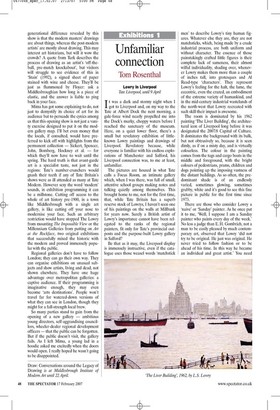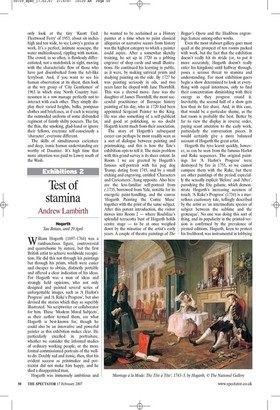Unfamiliar connection
Tom Rosenthal Lowry in Liverpool Tate Liveipool, until 9 April T t was a dark and stormy night when I I got to Liverpool and, on my way to the Tate at Albert Dock the next morning, a gale-force wind nearly propelled me into the Dock's murky, choppy waters before I reached the sanctuary of the museum. Here, on a quiet lower floor, there's a small but revelatory exhibition of littleknown Lowry paintings and drawings of Liverpool. Revelatory because, while everyone is familiar with his endless explorations of Manchester and Salford, his Liverpool connection was, to me at least, unfamiliar.
The pictures are housed in what Tate calls a Focus Room, an intimate gallery which, when I was there, was full of small, attentive school groups making notes and talking quietly among themselves. This brought home to me, not for the first time, that, while Tate Britain has a superb reserve stock of Lowrys, I haven't seen one of his paintings on the walls at Millbank for years now. Surely a British artist of Lowry's importance cannot have been relegated to the ranks of the regional painters, fit only for Tate's provincial outposts and the purpose-built Lowry gallery in Salford?
Be that as it may, the Liverpool display is immensely instructive, even if the catalogue uses those weasel words 'matchstick men' to describe Lowry's tiny human figures. Whatever else they are, they are not matchsticks, which, being made by a crude industrial process, are both uniform and without character. The essence of those painstakingly crafted little figures is their complete lack of sameness, their almost wilful individuality, shading over, whenever Lowry makes them more than a couple of inches tall, into grotesques and Al Read-type 'characters'. They represent Lowry's feeling for the halt, the lame, the eccentric, even the crazed, an embodiment of the extreme variety of humankind, and in the mid-century industrial wastelands of the north-west that Lowry recreated with such skill their impact is awesome.
The room is dominated by his 1962 painting 'The Liver Building', the architectural icon of Liverpool long before it was designated the 2007/8 Capital of Culture. It dominates the background with its bulk, but not obtrusively so, because it is seen dimly, as if on a misty day, and is virtually colourless. The colour in the painting comes from the tugs and cargo boats in the middle and foreground, with the bright colours of pedestrians, prams, children and dogs pointing up the imposing vastness of the distant buildings. As so often, the predominant shade is of an endlessly varied, sometimes glowing, sometimes grubby, white and it's good to see this fine picture in public for the first time since 1973.
There are those who consider Lowry a 'naive' or 'Sunday' painter. As he once put it to me, 'Well, I suppose I am a Sunday painter who paints every day of the week.' No less a judge than E. H. Gombrich, not a man to be easily pleased by much contemporary art, observed that Lowry 'did not try to be original. He just was original. He never tried to follow fashion or to be ahead of his time. In this way he became an individual and great artist.' You need only look at the tiny 'Knott End: Fleetwood Ferry' of 1953, about six inches high and ten wide, to see Lowry's genius at work. It's a perfect, intimate seascape, the water multicoloured, rippling with motion. The crowd, as so often, is flawlessly differentiated, not a matchstick in sight, moving with the characteristic flow of those who have just disembarked from the tub-like ferryboat. And, if you want to see his human observation at its slyest, then look at the wry group of 'City Gentlemen' of 1963 in which nine North Country businessmen in a row manage perfectly not to interact with each other. They simply display their varied heights, bulks, pompous clothes and briefcases, as if each is wearing the outmoded uniform of some disbanded regiment of faintly shifty poseurs. The fat, the thin, the smoking, glad-hand or ignore their fellows, everyone self-consciously a 'character', everyone different.
The skills of simultaneous caricature and deep, ironic human understanding are worthy of Daumier. It's high time that more attention was paid to Lowry south of the Wash.


























































 Previous page
Previous page